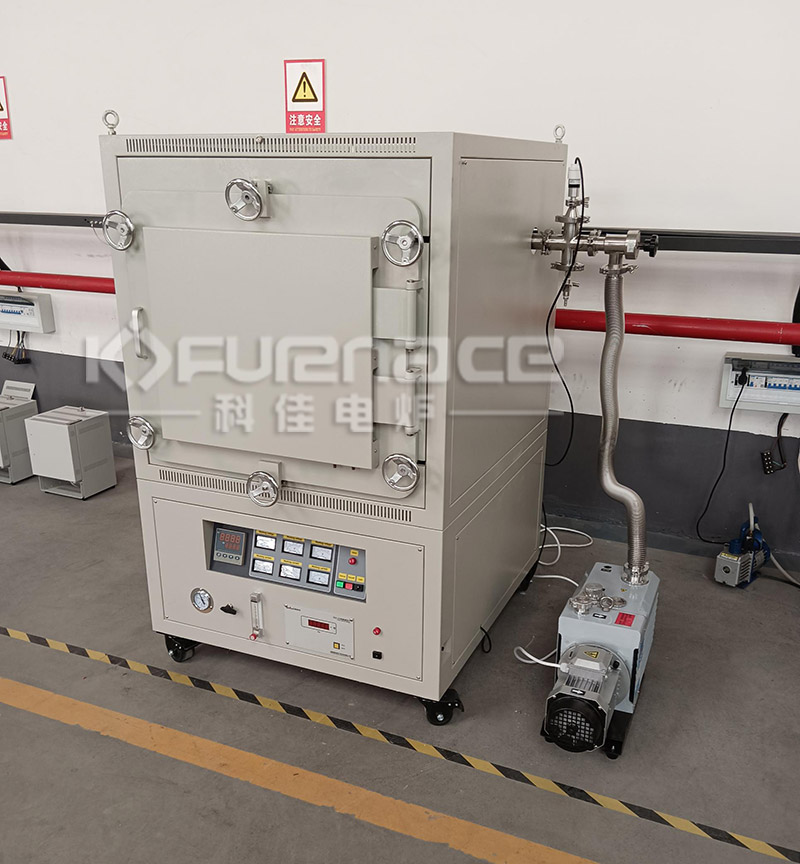Vacuum atmosphere furnaces have a wide range of applications in scientific research, providing important experimental platforms for research in multiple fields such as materials science, chemical engineering, physics, biomedical science, etc. Let’s take a detailed look below!

A commonly used high-temperature box type atmosphere furnace (click on the image to view product details)
1. Material synthesis and preparation
New material research and development: Vacuum atmosphere furnaces can be used to synthesize various new materials, such as high-performance ceramics, metal alloys, nanomaterials, etc. By precisely controlling the atmosphere and temperature inside the furnace, the synthesis conditions of materials can be optimized, and the relationship between the microstructure and properties of materials can be explored.
Material modification: By utilizing the high-temperature environment of a vacuum atmosphere furnace, existing materials can be modified to improve their physical and chemical properties and enhance their application performance.
2. Heat treatment and heat curing
Material heat treatment: Vacuum atmosphere furnace can be used for the heat treatment process of metals, ceramics, plastics and other materials, such as annealing, quenching, tempering, etc. By precisely controlling the atmosphere and temperature, the internal stress of the material can be eliminated, and its microstructure and properties can be improved.
Thermal curing: In the fields of composite materials, coatings, etc., vacuum atmosphere furnaces can be used for the thermal curing process of materials to improve their strength and durability.
3. Crystal growth and thin film deposition
Crystal growth: In an oxygen free or low oxygen environment, a vacuum atmosphere furnace can be used to grow single crystal or polycrystalline materials, such as silicon chips, gallium arsenide chips, etc. By precisely controlling the atmosphere and temperature, high-quality crystalline materials can be obtained.
Thin film deposition: Vacuum atmosphere furnaces can also be used for thin film deposition techniques such as chemical vapor deposition (CVD) to prepare thin film materials with specific functions.
4. Catalytic reactions and surface modification
Catalytic reactions: In the field of catalytic chemistry, vacuum atmosphere furnaces can be used to study the preparation and performance evaluation of catalysts. By precisely controlling the atmosphere and temperature, it is possible to simulate the working conditions of catalysts under actual reaction conditions.
Surface modification: By utilizing the high-temperature environment of a vacuum atmosphere furnace, material surfaces can be modified, such as ion implantation, sputtering coating, etc., to improve the physical and chemical properties of the material surface.
5. Biomedical research
Cell culture: In anaerobic or low oxygen environments, a vacuum atmosphere furnace can be used for cell culture experiments to simulate the growth environment of cells in vivo.
Biomaterials research: Vacuum atmosphere furnaces can also be used for surface modification and performance evaluation of biomaterials, providing support for the development of biomedical fields.
6. Research on Energy Materials
Research on battery materials: Vacuum atmosphere furnaces can be used for the synthesis, modification, and performance evaluation of battery materials such as lithium-ion batteries and solar cells. By precisely controlling the atmosphere and temperature, the structure and properties of battery materials can be optimized, and their electrochemical performance can be improved.
Research on hydrogen storage materials: In the field of hydrogen storage materials, vacuum atmosphere furnaces can be used to study the synthesis, hydrogen storage performance, and release performance of hydrogen storage materials.
Advantages of Vacuum Atmosphere Furnace
Highly Pure Environment: A vacuum atmosphere furnace can create and maintain a highly pure vacuum environment, avoiding interference from external gases, dust, and other impurities on the sample, ensuring the accuracy and reliability of experimental results.
Accurate atmosphere control: The vacuum atmosphere furnace can precisely control parameters such as the type, concentration, and flow rate of the atmosphere inside the furnace according to experimental requirements, providing a specific reaction atmosphere for the experiment.
Good temperature control system: By adopting a good temperature control system, the vacuum atmosphere furnace can achieve rapid response and precise control of the temperature inside the furnace, meeting the requirements of precise temperature control in experiments.

A commonly used box type atmosphere furnace (click on the image to view product details)
In summary, vacuum atmosphere furnaces have broad application prospects and important research value in scientific research. With the continuous advancement of technology and the increasing industrial demand, the application fields of vacuum atmosphere furnaces will further expand and deepen.Click to learn more Atmosphere Furnaces! Or click on online customer service to learn more about product information!